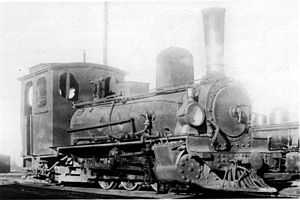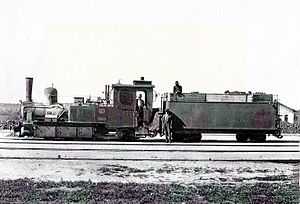South West African Class Hb
| South West African Class Hb 0-6-2T ex DSWA Class Hb 0-6-2T | |
|---|---|
|
Class Hb no. 61 with optional coal and water tender and dust covers to protect the motion, c. 1930 | |
| Type and origin | |
| Power type | Steam |
| Designer | Henschel and Son |
| Builder | Henschel and Son |
| Serial number | 7298-7300/1905, 7623-7626/1906, 7740-7745/1908, 8610-8611/1907 [1] |
| Model | Class Hb |
| Build date | 1905-1908 |
| Total produced | 15 |
| Specifications | |
| Configuration | 0-6-2T |
| Gauge | 600 mm (1 ft 11 5⁄8 in) narrow gauge |
| Driver diameter | 33 7⁄8 in (860 mm) |
| Wheelbase |
6 ft 4 1⁄2 in (1.943 m) coupled 13 ft 3 1⁄2 in (4.051 m) engine |
| Length | 25 ft 3⁄4 in (7.639 m) |
| Width | 7 ft 2 1⁄2 in (2.197 m) |
| Height | 10 ft 6 in (3.200 m) |
| Weight on drivers | 17.7 long tons (18.0 t) |
| Locomotive weight | 22 6⁄20 long tons (22.7 t) w/o |
| Fuel type | Coal |
| Fuel capacity | 0.6 long tons (0.6 t) |
| Water capacity | 220 imp gal (1,000 l; 260 US gal) |
| Boiler | 4 ft 7 1⁄2 in (1.410 m) pitch[2] |
| Boiler pressure | 171 psi (1,180 kPa) |
| Firegrate area | 11.2 sq ft (1.041 m2) |
| Cylinders | Two |
| Cylinder size |
320 mm (13 in) bore 450 mm (18 in) stroke |
| Valve gear | Allan [3] |
| Performance figures | |
| Tractive effort | 10,263 lbf (46 kN) at 75% pressure |
| Career | |
| Operator(s) |
Otavi Mining and Railway Company South African Railways |
| Class | Otavi Class Hb |
| Number in class | 15 |
| Number(s) | 51-65 [1] |
| Delivered | 1905-1908 |
| First run | 1905 [3] |
The South West African Class Hb 0-6-2T of 1905 is a South West African steam locomotive from the Deutsch-Südwest-Afrika era.
Between 1905 and 1908 the German Administration in Deutsch-Südwest-Afrika, now Namibia, acquired fifteen Class Hb tank locomotives with a 0-6-2 wheel arrangement for the Otavi Mining and Railway Company. Six of these locomotives survived to be taken onto the roster of the South African Railways after World War I.[3]
Manufacturer
Between 1905 and 1908 fifteen 600 millimetres (23.6 inches) narrow gauge 0-6-2 tank and tank-and-tender steam locomotives were built for the German Administration in Deutsch-Südwest-Afrika (DSWA) by Henschel and Son in Germany. They were designated Class Hb and numbered in the range from 51 to 65. The locomotives were leased to the Otavi Mining and Railway Company that operated a narrow gauge railway across the Namib Desert between Tsumeb and Swakopmund.[1][3]
Characteristics
The locomotives used Allan valve gear and were equipped with dust covers to protect the motion from wind-blown sand in the Namib Desert. The "Hb" classification identified the locomotive type as the second class to have been built for DSWA by Henschel. They were delivered in four batches.[1][3]
- The first three locomotives were delivered in 1905, with works numbers in the range from 7298 to 7300 and numbered in the range from 51 to 53.[1]
- Four more followed in 1906, with works numbers in the range from 7623 to 7626 and numbered in the range from 54 to 57.[1]
- Two arrived in 1907, with works numbers 8610 and 8611 and numbered 64 and 65.[1]
- Six were delivered in 1908, with works numbers in the range from 7740 to 7745 and numbered in the range from 58 to 63. These last six locomotives were delivered as tank-and-tender engines, equipped with optional coal and water tenders.[1]
South African Railways
During World War I the former German Colony came under South African administration and the railways in DSWA came under control of the Union Defence Force. Control of all railway operations in South West Africa (SWA) was passed on from the Military to the Director of Railways in Windhoek on 1 August 1915. On 1 April 1922 all the railway lines and rolling stock in the territory became part of the South African Railways (SAR).[3]
Six of these locomotives, numbers 51, 54, 56, 61, 62 and 65, survived into the SAR era. They retained the German Colonial Hb classification and running numbers while in SAR service.[2][3]

Photographic evidence as shown alongside suggests that at some stage, probably in the SAR era, the side tanks on some or all of the remaining locomotives were removed.
See also
- List of South African locomotive classes
- South African locomotive history
- The 0-6-2 wheel arrangement
References
|
- ↑ 1.0 1.1 1.2 1.3 1.4 1.5 1.6 1.7 Henschel-Lieferliste (Henschel & Son works list), compiled by Dietmar Stresow
- ↑ 2.0 2.1 Dulez, Jean A. (2012). Railways of Southern Africa 150 Years (Commemorating One Hundred and Fifty Years of Railways on the Sub-Continent - Complete Motive Power Classifications and Famous Trains - 1860-2011) (1st ed.). Garden View, Johannesburg, South Africa: Vidrail Productions. p. 235. ISBN 9 780620 512282.
- ↑ 3.0 3.1 3.2 3.3 3.4 3.5 3.6 Paxton, Leith; Bourne, David (1985). Locomotives of the South African Railways (1st ed.). Cape Town: Struik. p. 116. ISBN 0869772112.
